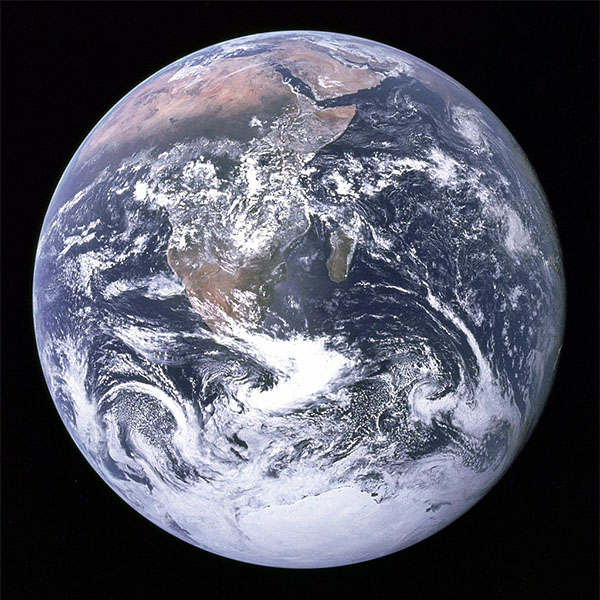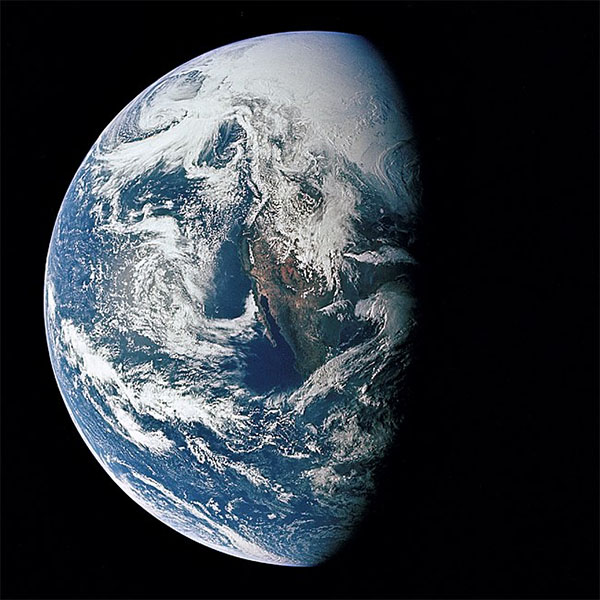[audio version of this article]
The most straightforward way to check the shape of the Earth is to look at it. There’s one small problem, though. To see the shape of the Earth as a whole, you need to be far enough away from it. For most of human history, this has not been possible. It was only with the advent of the space age that our technology has allowed us to send a human being, or a camera, more than a few kilometres from the surface.
The earliest photo of the whole Earth from space was taken by NASA’s ATS-3 weather and communications satellite in 1967. The photo was taken from geostationary orbit, some 34,000 kilometres above the surface of the Earth, and shows most of the western hemisphere, with South America most prominent. And you can see quite clearly that the Earth is round. It looks spherical, for the other landmasses that we know are there are hidden around the other side, and there is foreshortening of the features near the edges which matches our experience with spherical objects.
A more famous image of Earth taken from space is the Blue Marble image, captured by the Apollo 17 astronauts on their way to the Moon in 1972. This photo was taken from a distance of about 45,000 kilometres.
This image is clearer and it’s arguably easier to see the spherical shape of the planet. Both these photos were taken with the full hemisphere lit by the sun.
The Apollo 13 astronauts, in their ill-fated flight, captured a different view, with part of the Earth in darkness because the sun was not behind them.
Here it is even easier to get a feeling for the round, spherical shape of Earth, because our experience with the way light falls on round objects helps our minds make sense of the curved shadow.
Well, that’s pretty definitive. But what else do we have?



I assume you’re saving Foucault for the end?
It’s definitely in the list, but I haven’t decided just where yet.
My fave:
If the world were flat, you could go to the top of Chicago’s Willis Tower (the tallest building in the United States) w/ a telescope, and see the Burj Khalifa in Dubai (the tallest building in the world) , along w/ everything else on Earth
I don’t think this will convince someone who would argue the photos are faked. Though I don’t know if flat earthers really believe it or are just pretending to
Neither do I, and it’s not meant to do that. The site is for people who enjoy cool science, not for flat earthers.
Both. Depends on the flat earther in question.
These are amazing photos.
What always surprise me (mostly because I keep forgetting it), is the vastness of the cloud systems in our atmosphere. I tend to imagine it like the typical clear day with sparse clouds here and there, but it seems to not scale well when you move far away from the surface.
P.S.: Keep up with your amazing work on Irregular Webcomic: I’m a big fan. <3
It’s a chuckle to compare scifi shows before and after Apollo. In Star Trek for example, the planets visited never have clouds.
Besides, if the Earth were flat, cats would have pushed everything over the edge by now.
That should have been a Terry Pratchett joke, but I don’t think it ever was.
Surely that has to be one of the 100 arguments.
That is my favorite proof ever.
I particularly like the Apollo 8 “Earthrise” photo, though it is harder to recognize continents in it. (Earth is rising from the point of view of a spacecraft in orbit around the Moon. )